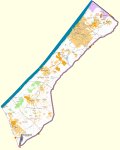Visiting Gaza
16. May 2010 - 26. May 2010A report by Peter Voss, part 6
Mouse click to enlarge photos, Alt + 'left arrow' to return
|
Day by day account
Saturday, May 22, 2010 This was my day to return to Egypt. The Rafah crossing had officially closed on Wednesday. Therefore I figured that I would either get through the crossing pretty fast, because very few people would show up, or that I might have a problem. In both cases I figured there would be no rush to get to the crossing. I still had in mind to get some more information from the UN. Therefore I showed up shortly after 8:30 a.m. at UNRWA headquarters, hoping that I would find somebody to talk to. I was told, though, that I would basically need an apointment. However, somebody might be willing to talk to me. He was expected to arrive at 10:00 a.m.. I had noticed many students in the area, so I asked whether there was a stationery store nearby. I had heard so much about paper and pencils not getting into Gaza that I wanted to see what the actual situation looked like. There were several along the next main street, Jamal Abed El Naser Street. I went into several of these stores and took some photos. The situation was similar to that in the supermarkets. The basic supplies were there and came through the tunnels. Ballpoint pens from China, the better ones for 6 Shekels ($ 1.50), the cheapest ones for 1 Shekel. I photographed a stack of UHU glue, a well-known brand in Germany. It was slightly cheaper than in Germany and came from Croatia. In one of the stores I asked the storekeeper what would happen if I wanted 5000 ballpoint pens. He said he would have to order them. It would take about a week. I still had some time and was wandering along the road. On one of the buildings a whole window was covered by one of the typical big signs. It was for a 'German Development Project'. Going one window further down it became obvious that this was another project that had not gone anywhere. Across the street I noticed the entrance to the 'The Islamic University of Gaza'. I went over, saw an interesting building in the background, and was wondering whether I would be allowed in. A student carrying a laptop took me in and brought me to the office of Mr. Ayesh, the vice director of the public relations office. He gave me a basic explanation on the university and then went to the back section of the complex with me inorder to show me a big hole in the ground. This was the location of what used to be the laboratory building, the most valuable building in the complex. It was bombarded during operation 'Cast Lead'. The building I had seen through the entrance gate was the building of the Faculty of Engineering. The campus has two entrances, one for the male students at the main street and one for the female students at the side where the western entrance to the UNRWA compound is also located. The panorama below was taken in the 'female' courtyard. It was time to go to UNRWA again. Mr. Ayesh accompanied me to the side entrance. On the way there we met several professors from the engineering department. To my surprise two of them spoke German. We exchanged business cards. 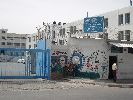 UNRWA western entrance UNRWA western entrance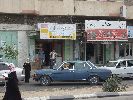 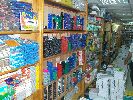 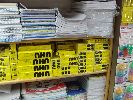  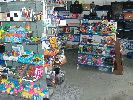 stationery stores 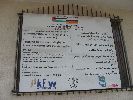 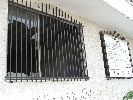 German project 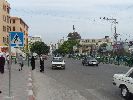  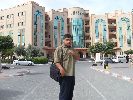  The Islamic University of Gaza; the student that took me in; Mr. Ayesh showing me the location of the former laboratory building. When I arrived at the UNRWA gate my prospective interview partner had not shown up yet. After all, it was the day after the weekend. I was given the telephone number of the UNRWA press officer, whom I decided to call sometime later. I got my luggage and took off for Rafah. As we were driving out of Gaza City, we came by a block of modern apartment buildings. The panorama photos below needed some adjustment because they were taken out of the moving car. The sequence of photos was actually from right to left.   Modern apartment buildings near Al Aqsa Street Some shots as we were going down Salah El-Deen Street. 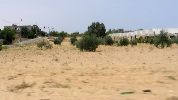 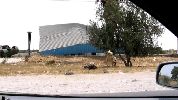 As dry as everything was it seemed that not even weeds would grow. The gas stations along the road were quite modern. This one had collapsed in a very orderly fashion during operation 'Cast Lead'. 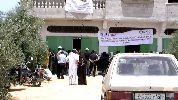 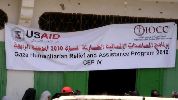 Picking up aid. A truck with water tanks and pipes apparently had a problem. We turned around to have a closer look. My driver thought that what he saw was very funny. 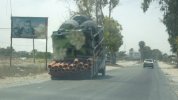 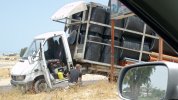
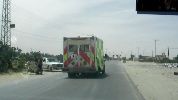 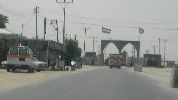  As we approached the outside gate of the Palestinian Rafah terminal (in the background) a Viva Palestina ambulance drove past us. During my stay I saw several of them. On the left hand side of the road were cafes. The guards at the gates would not let anybody into the terminal unless they had the information or at least the feeling that he or she would have a chance to continue to the Egyptian side. It seemed that I had this chance. I was told that I had to wait a few hours until a group of Americans would show up. I sat down in the lounge and watched a singer and dancers on Al-Aksa TV. At the end pictures of the Dome of the Rock in Jerusalem were shown, a place which for Gazans currently is about as far away as the moon. 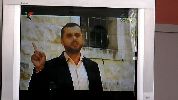 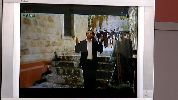 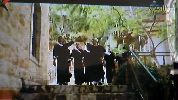 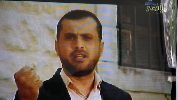 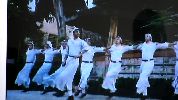 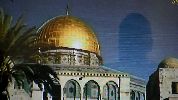 The Americans never came. Around 6:30 p.m. I was told that they would come the next day and that the terminal would be closed. It was time to call Cairo. After some time my contact told me that the Egyptian side did not expect me before Wednesday. I learned later that Wednesday and Thursday were the days when there was some traffic going through Rafah even when it was officially closed. In the meantime Rafah is always open. This, however, does not mean that it has become easy to get in or out. It was getting dark. A guard helped me drag my luggage to the outer gate. With him I had my only really unpleasant experience, because when it came to get a taxi he tried to extort money from me. It did not work out for him, because I had telephone numbers for two taxi drivers. I did not need them, though, since I could go to Khan Yunis with a shared taxi and from there with another shared taxi to the Beach Hotel. The taxi driver, an older man, would not take any money from me. Somebody had already paid my fare. 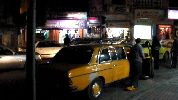 Changing taxis in Khan Yunis at 9:30 p.m. Sunday, May 23, 2010 It was pretty clear that I would have to stay until Wednesday. However, since I did not have anything in writing and since as far as I knew my permit had run out on Saturday, I did not want to take any risk. Therefore I went back to the Rafah crossing. I was in telephone contact with one of the officers in Rafah and around 10 a.m. he indicated that I should get down there. I learned later from a bystander that the American delegation apparently had already gone through by the time I arrived. At this point it was most important for me to get out at all (one morning at breakfast I had met an English girl who once was stuck in Gaza for four months). I had actually started to like the idea that I would have some extra days. So I just let the guards at the gate and the officer know that I was there and sat down in the cafe next to the gate. There was not much going on. Two large delivery trucks loaded with soft drinks (everything probably brought in through the tunnels) pulled in. Business could not have been all that great, because they stood there for about an hour. One of their bottles got too much sunlight and exploded. A large number of empty heavy trucks arrived and stood there for a while. They then did not continue through the gate but seemed to circle it going in direction towards the crossing. They were actually on their way to the Kerem Shalom crossing to Israel. The road to this crossing runs parallel to the border and between the Palestinian and the Egyptian terminal. About an hour later the trucks returned loaded with what seemed to be boxes with fruit and vegetables. 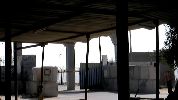 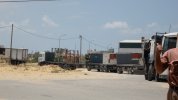 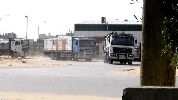 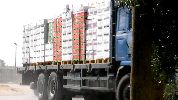 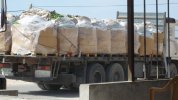 View from the cafe at the gate; trucks going to Kerem Shalom and returning I stayed for three hours. By that time the Palestinian officer had apparently decided not to answer my phone calls anymore. I informed my contact in Cairo that I would return to the hotel and would try again on Wednesday. By the time I arrived at the hotel it was already late afternoon. I assembled my bike again and drove over to the outside mole of the harbor in order to have a closer look at what was going on there. The work at the harbor in preparation for the arrival of the flotilla was mentioned in the Israeli newspapers. I noticed a shovel crane on a pontoon that could hardly reach the water. There was also a suction boat that was probably more effective. I also had a look around at the mole. The Israelis apparently had wasted quite a bit of ammunition in the attempt to destroy it. 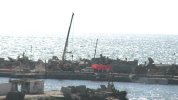 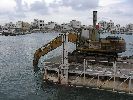 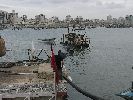 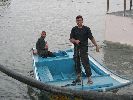 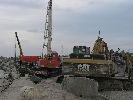 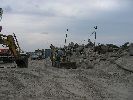 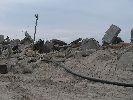
Continuation in part 7 Back to contents page
|
